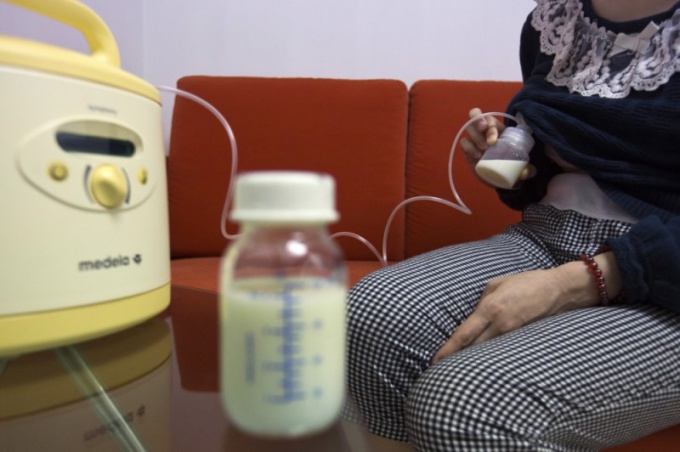The composition of milk adjusts to the baby, in the summer, when the little one is in great need of liquid, human milk becomes more liquid and less nutritious. For this reason, the child receiving the breast on demand, up to six months does not need dobivanii water. The freezing changes the structure of milk, but because it may look transparent and "nonfat". This is normal, the nutritional value of it has not changed, and that milk can feed the baby.
In some women, colostrum begins to stand out at the end of pregnancy, others appear after the first application of the child. This is the secret of the breast, with yellowish, white or cream color. The taste it can be salty-sweet. The colostrum is quite thick and a small amount of it meets the needs of the newborn in food. 3-4 days after the start of feeding Mature milk comes in-colostrum becomes lighter and liquid, its volume increases. Usually the yellow color of colostrum and transitional milk notice women who use a breastpump. This shade is the norm, and with proper lactation by the end of the first week the child will be to Mature breast milk in sufficient quantity.
Most women notice is the foreground color of milk. It is very thin, almost transparent, whitish. Front milk consists of water, vitamins, and milk sugar, it fills the child's need for fluid and carbohydrates. As suckling the child begins to receive the hind milk - white and more dense structure. It is the most nutritious part of the milk ─ in the rear portions contain proteins and fats. If you squeeze out a drop of milk at the end of the feeding, you can be sure ─ the milk is really white. Some babies refuse to suck the back portion, as it requires more effort ─ hastily the mother offers the second breast and the baby gets only the liquid part and a large amount of milk sugar. It is linked to this intestinal disorders, frothy stool and intestinal colic ─ in the child's body does not have enough enzymes to digest milk sugar. Child eats, not gaining weight, frequent waking. You want to adjust breastfeeding and not to introduce supplementary feeding.
If a woman breastfeeds for a long time, after about 1.5 years after the start of lactation, the milk becomes less, it is more dense in composition and color like colostrum. The main objective of breast milk at this stage is to provide the child's body immune protection, as it is already well placed to make their own food. Milk is usually yellow, very thick.
The appearance of blood in milk may indicate bleeding due to benign and malignant neoplasms in the milky ducts, often during high tides small blood vessels burst and blood gets into the milk. Cracks and tiny nipples, tight underwear, prolonged compression of the breast can often cause blood in the milk. This milk can be fed, but you must consult a doctor to find and remove the cause of bleeding.
When purulent mastitis perhaps pus in the thoracic duct. According to who recommendations, feed the baby breast milk from the affected gland, but high content of pus in milk in children during the first months of life can cause problems with the chair. If during the treatment of purulent mastitis near a nursing woman there is a pediatrician or an obstetrician-gynecologist who have the knowledge and experience of establishing breastfeeding when purulent mastitis, it is better to abandon the feeding of the patient cancer. Neat regular frequent pumping will help to maintain lactation and prevent the defeat of the other lobes of the gland. Greenish tint milk may be the case if the child is over 12 hours is not applied to the chest. A woman can Express it, but it is safe for the child.
To increase the consumption of the hind milk only the frequent feedings to the breast, big breaks between feedings do not contribute to the accumulation of "fatty" milk, but can cause lactostasis or mastitis.
Colostrum and transitional milk
In some women, colostrum begins to stand out at the end of pregnancy, others appear after the first application of the child. This is the secret of the breast, with yellowish, white or cream color. The taste it can be salty-sweet. The colostrum is quite thick and a small amount of it meets the needs of the newborn in food. 3-4 days after the start of feeding Mature milk comes in-colostrum becomes lighter and liquid, its volume increases. Usually the yellow color of colostrum and transitional milk notice women who use a breastpump. This shade is the norm, and with proper lactation by the end of the first week the child will be to Mature breast milk in sufficient quantity.
Rear and front milk
Most women notice is the foreground color of milk. It is very thin, almost transparent, whitish. Front milk consists of water, vitamins, and milk sugar, it fills the child's need for fluid and carbohydrates. As suckling the child begins to receive the hind milk - white and more dense structure. It is the most nutritious part of the milk ─ in the rear portions contain proteins and fats. If you squeeze out a drop of milk at the end of the feeding, you can be sure ─ the milk is really white. Some babies refuse to suck the back portion, as it requires more effort ─ hastily the mother offers the second breast and the baby gets only the liquid part and a large amount of milk sugar. It is linked to this intestinal disorders, frothy stool and intestinal colic ─ in the child's body does not have enough enzymes to digest milk sugar. Child eats, not gaining weight, frequent waking. You want to adjust breastfeeding and not to introduce supplementary feeding.
The color of milk at the stage of involution
If a woman breastfeeds for a long time, after about 1.5 years after the start of lactation, the milk becomes less, it is more dense in composition and color like colostrum. The main objective of breast milk at this stage is to provide the child's body immune protection, as it is already well placed to make their own food. Milk is usually yellow, very thick.
Blood in the milk
The appearance of blood in milk may indicate bleeding due to benign and malignant neoplasms in the milky ducts, often during high tides small blood vessels burst and blood gets into the milk. Cracks and tiny nipples, tight underwear, prolonged compression of the breast can often cause blood in the milk. This milk can be fed, but you must consult a doctor to find and remove the cause of bleeding.
Pus in milk
When purulent mastitis perhaps pus in the thoracic duct. According to who recommendations, feed the baby breast milk from the affected gland, but high content of pus in milk in children during the first months of life can cause problems with the chair. If during the treatment of purulent mastitis near a nursing woman there is a pediatrician or an obstetrician-gynecologist who have the knowledge and experience of establishing breastfeeding when purulent mastitis, it is better to abandon the feeding of the patient cancer. Neat regular frequent pumping will help to maintain lactation and prevent the defeat of the other lobes of the gland. Greenish tint milk may be the case if the child is over 12 hours is not applied to the chest. A woman can Express it, but it is safe for the child.
To increase the consumption of the hind milk only the frequent feedings to the breast, big breaks between feedings do not contribute to the accumulation of "fatty" milk, but can cause lactostasis or mastitis.



